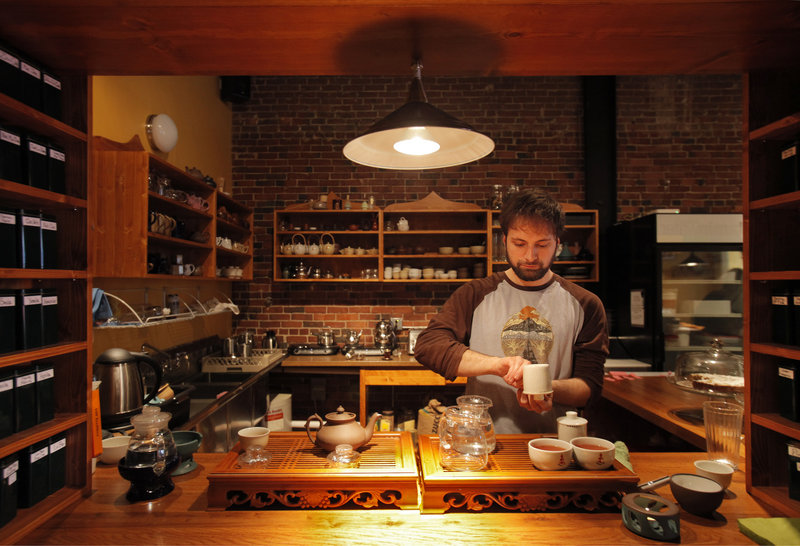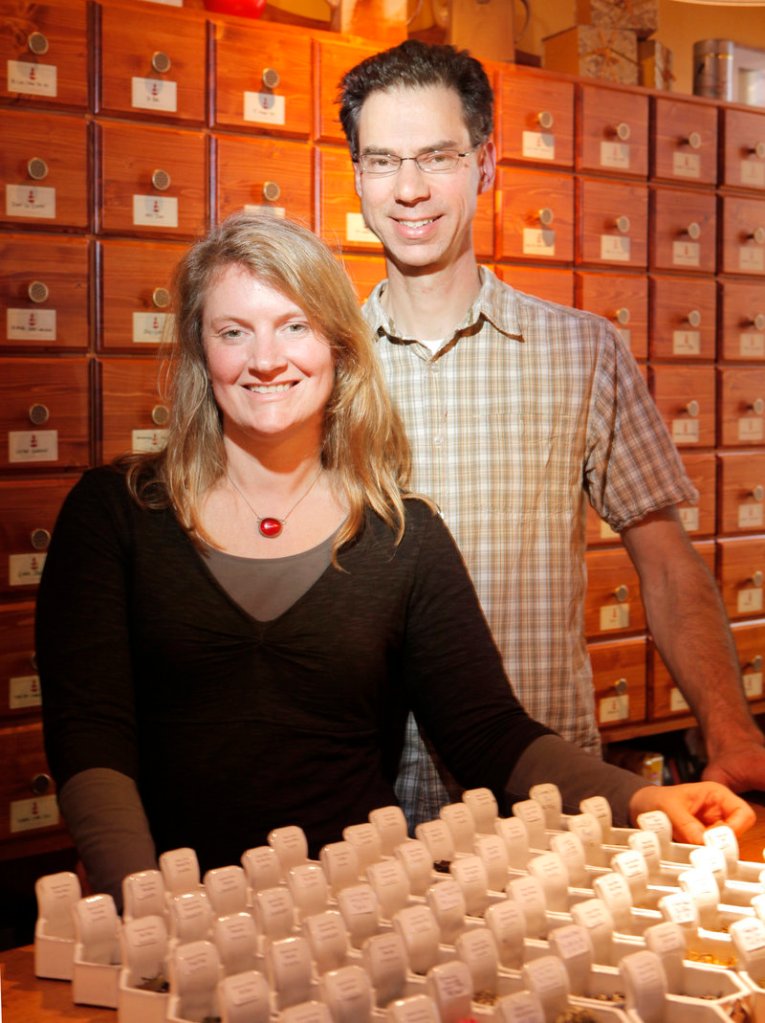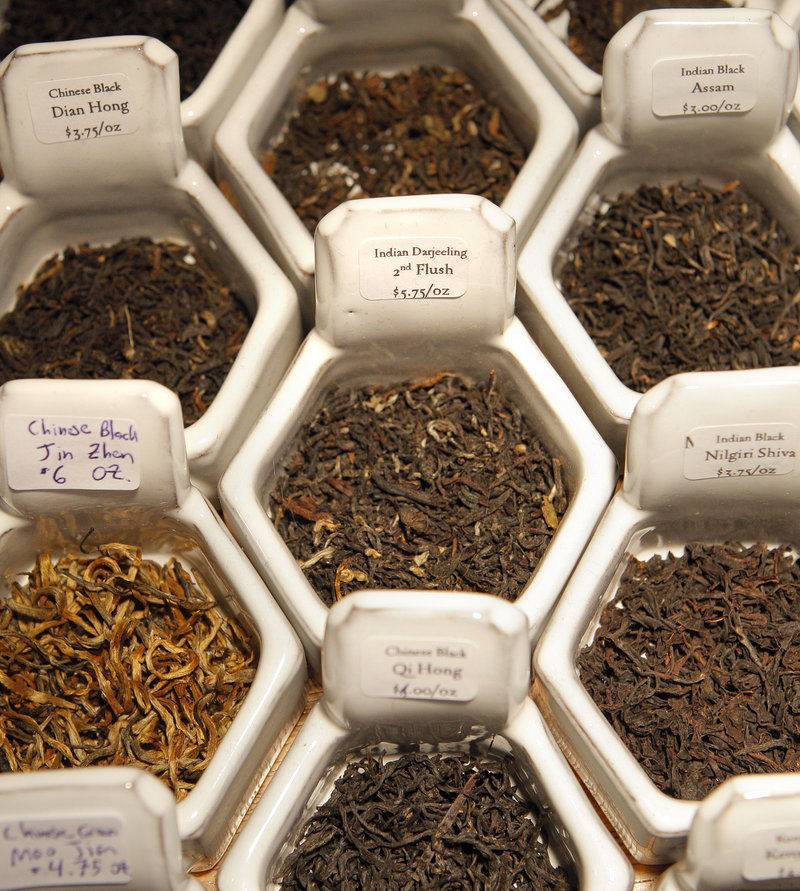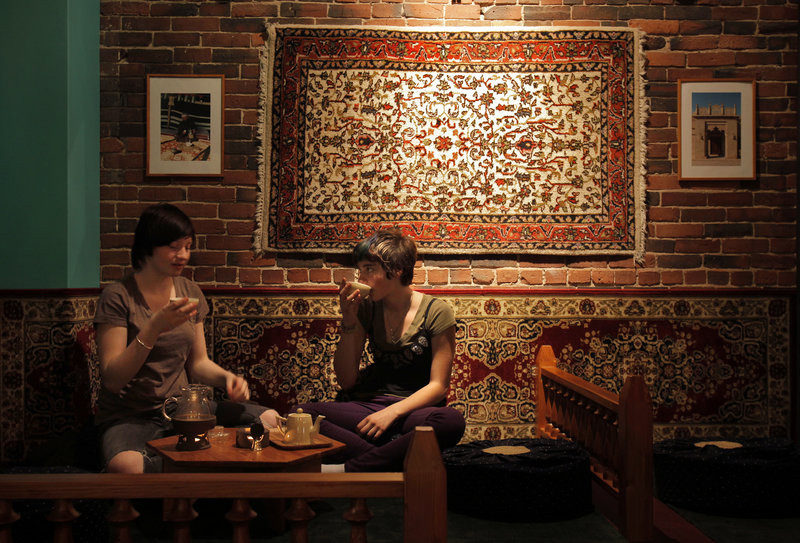PORTLAND – Walking into Dobra Tea feels like stumbling upon an eastern European cafe.
The arched windows, the warm mustard and burnt-orange walls, and the curvy woodworking details that look like something out of the genie’s bottle all shift your mood from rat-race mode to a lower-gear humming with old-world Bohemian tranquility.
World music floats in the background. Local art hangs on the walls. Oriental rugs from second-hand stores in Germany and the Czech Republic adorn the tea house floor.
There are chairs and tables from the Czech Republic, or if you prefer, comfy sofas to sink into while you peruse the thick binder that contains the menu featuring teas from China, Japan, India, Sri Lanka, Taiwan, Kenya, Nepal and Turkey. For those who would like to sit on the floor, there is a separate, darker room with plump, colorful cushions scattered around low tables.
Take some time to decide which of the more than 100 teas you’d like to try, then ring the little bell on your table for service.
When Ellen Kanner and her husband, Ray Marcotte, first walked into a similar Dobra Tea room in Burlington, Vt., they immediately felt at ease and knew that this was what they were meant to do.
“We were like, ‘Oh wow, this is really cool,’ ” Kanner said over a “Treasure Trove” sampler of three Chinese teas. “We were looking for something completely different. I had been doing Web development, and he had been commuting two hours twice a week to a job in western Massachusetts, so that was a little crazy.”
Kanner and Marcotte, an academic reference librarian, had been living in Hanover, N.H. Once they decided to open their own tea room, they settled on coming back to Maine to open their first small business together.
But first, they flew to Prague to meet the creators of the Dobra Tea experience, Jiri Simsa and Ales Jurina, and tour their tea rooms. When the Czech Republic was a Communist state, high-quality teas had to be smuggled into the country because only the elite could afford them. A few years after the fall of communism, the first Dobra Tea opened in Wenceslav Square in Prague, and they have spread across eastern Europe ever since.
“There are over 20 Dobra Tea rooms in eastern Europe,” Marcotte said. “Most of them are in the Czech Republic. There are a few in Slovakia, Hungary and Poland.”
NO. 4 IN THE USA
The Portland Dobra Tea, located above Bull Moose Music in the old Maple’s Gelato space at 151 Middle St., is the fourth one in the United States. The Burlington tea room opened in 2003, followed by another one in Madison, Wis., and a third in Asheville, N.C.
Kanner and Marcotte call their arrangement with the Czech tea gurus “a business partnership.” If the relationship with potential new owners clicks, the original Dobra licenses the logo to them, provides an operations manual and access to tea training, and ships a container filled with tables and chairs, rugs and all the things that will give a new tea room a certain look and feel. They also provide most of the tea through the suppliers they have already forged relationships with over the years.
“Dobra doesn’t really want to do franchising,” Kanner said. “They don’t want to have just anyone buy into it. They want to let an owner do this and not control it. They don’t want to control everything.”
The Portland Dobra was the first opened by people who had never worked in one of the tea rooms before. “That’s unique,” Marcotte said. “All of the other owners worked in a Dobra for at least two or three years before they opened their own.”
Kanner and Marcotte have both been undergoing lots of intensive tea training, but they also hired as their resident tea expert Matthew Frayer, who has worked in the Burlington Dobra as well as another tea shop, lived in Asia, and traveled to several tea-producing countries. They’ll be offering tea classes to the public in the near future.
‘WHILE OPENING LETTERS’
The menu at Dobra, which also includes desserts and light fare such as “Cous Cous Casablanca,” could be overwhelming — especially if you get lost in the wisdom of the Chinese tea classic Ch’a-su, which spells out suitable moments for drinking tea. They include “while opening letters” and “in torrential rain.”
Frayer brings over a selection of three Chinese teas called a “Treasure Trove,” each steeped and served in a white Chinese tea set. It includes Lu Cha, a green tea; Hong Cha, a black tea; and a pu-er called Hei Cha. All three teas come from the same plant.
“It’s the processing of the tea leaf that changes the class of the tea,” Marcotte explained. “Green tea is unoxidized, black tea is fully oxidized, and pu-er tea is not only oxidized, it’s fermented. So, as you can imagine, the flavor of the tea is very different, but they all start from the same plant. They all start from the same region in this case.”
The green tea is light and refreshing. Chinese green teas are more subtle than Japanese green teas, Marcotte said, because the tea leaf is pan-fired.
The black tea has a smokiness to it, and the pu-er is earthy, with a mustiness reminiscent of an old quilt.
Next, a dish called Pita Dahab on the menu arrives, with pita bread, goat cheese seasoned with cardamom, tomatoes and a bowl of olives. Kanner said she is working hard to source food locally; “it’s just a matter of finding it.”
“I need to find a good dolma maker, someone who makes nice stuffed grape leaves,” she said.
From the kitchen comes a cry of “Chai! Chai! Chai!” It’s the traditional cry of Indian chai wallahs, and the staff dutifully calls it out when a chai order is ready.
In the kitchen area at Dobra there is a tea-making area, row upon row of drawers filled with loose-leaf tea, and shelves of tea pots and tea cups from every culture. Rize Cay (ree-zay chai) is brewing in a Turkish pot. There is even a stash of yerbe mate gourds.
Pu-er tea pressed by a stone into round cakes is stored next to the drawers of loose-leaf tea.
“There’s all sorts of varieties,” Frayer said. “The one you had they call a ripe pu-er, so it’s dark and mellow and rich. And then there are the raw pu-ers, which have a greener, sharper taste.”
Even the owners of the Portland Dobra Tea have not yet sampled all the different teas they sell. Kanner said she’s partial to white peony, or bai-mu-dan, a white tea with a delicate flavor. Her husband doesn’t really have a favorite.
“Tea, for me, is more about how I’m feeling,” Marcotte said. “One time I might want this, another time I might want that. It depends on if I feel cold. It depends on my mood, I think, more than anything.
“I think there’s a tea for every mood.”
Staff Writer Meredith Goad can be contacted at 791-6332 or at: mgoad@pressherald.com
Follow her on Twitter at: twitter.com/MeredithGoad
Send questions/comments to the editors.







Comments are no longer available on this story